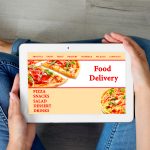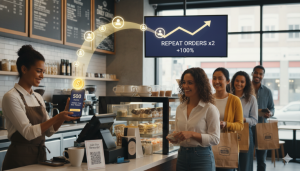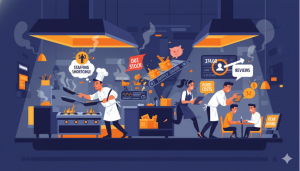Digital marketing for restaurants is all about connecting with customers and building relationships.
Through effective digital marketing, restaurants can attract new customers, keep them engaged, and convert them into loyal followers who will recommend your restaurant to their friends.
Approximately 90% of guests choose to research a restaurant before they go out to dine. This number is more than that of any other business type. This alone should indicate how important online marketing strategies for your restaurants are.
The competition is fierce, and if you want to stay in the game, you’ll need to conduct the right marketing for your restaurant business.
But online marketing strategies for restaurants are constantly evolving, making the process of deciding what is right for your business difficult.
Restaurant Marketing Strategies
There are a number of different restaurant marketing strategies that businesses can use to reach their target audience.
Some popular methods include social media, search engine optimization (SEO), and paid advertising.
Each strategy has its own strengths and weaknesses, so it’s important to choose the right one when devising marketing plans for restaurants.
Key Steps Implementing Digital Marketing For Restaurants
Here are some key steps for successfully implementing digital marketing for restaurants:
- Choose the right platform.
Restaurant websites should be built on platforms like WordPress or Drupal because they’re easy to use and provide customization options.
Additionally, these frameworks make it easy to manage content and integrate social media widgets into the site.
- Build an attractive website design.
A well-designed website will look professional and inviting, inspiring potential diners to visit the restaurant more often.
Use high-quality images, fonts, and layout elements to create a user interface that is both pleasing to the eye and functional.
Set up targeted online advertising campaigns.
Knowing the audience is crucial for any restaurant marketing plan.
Ads targeting specific audiences (such as people who live within commuting distance of your restaurant) can help you reach your target market more effectively than general ads displayed across all web pages.
Best Online Marketing for Restaurants
Here are some of the most effective strategies for online marketing for restaurants.
Digital marketing provides your restaurant with a chance to stand out against its competition, and attract new customers.
Here are some of the best online marketing strategies you can implement for your restaurant business.
Create a Social Media Presence
You cannot ignore social media, regardless of the type of business you run.
Getting your restaurant listed on social media sites like Twitter, Instagram, Facebook, and Google is a crucial part of any online marketing campaign.
Facebook alone has around 1.5 billion registered users. This makes it the simplest platform to get people’s attention on. As a result, using social media for your restaurant’s digital marketing aims is a no-brainer.
If you’re a restaurant, you should try to use these channels if you haven’t been doing so previously.
However, it is important to note that simply having an account won’t be enough; you’ll need to be active across the social media channels you choose to use.
It’s critical to interact with customers on social media. You must reply to their tweets, posts, and comments keeping interaction at a high.
Furthermore, strive to maintain a regular posting schedule. The visibility of digital marketing for restaurants is crucial. While this does not mean you have to post every day, try to keep some sort of consistency and avoid long periods of page inactivity.
Video marketing may also be shared through social media. Customers will remember and engage with videos since they are entertaining to watch, informational, and overall memorable and appealing.
One of the most effective methods to grow your brand, obtain referrals, and increase your online presence is to share it on social media. Especially when you consider that 48.9% of consumers use social media to locate new eateries.
The best aspect is that you have a wide range of free and paid advertising choices at your disposal with social media marketing.
Create a Dynamic and Interactive Website
With everything making a transition online, you need to ensure that you have the right amount of online presence and relevance.
Besides being active on social media platforms this also includes creating a dynamic and appealing website for your restaurant.
It can be argued that your business’ face is no longer your storefront. Especially when as great as 88% of people go online to discover products and services. With 57% of guests viewing websites of restaurants before selecting where to eat.
Your website, therefore, becomes one of the greatest, if not the most important factors in determining your restaurant’s reputation.
If your site isn’t valuable to your visitors, they’ll probably leave for a more appealing one that matches their needs. This means losing out on potential customers.
Therefore, your website should be professional, functional, and easy to navigate.
This includes making sure your website is mobile-friendly. Your potential consumers are likely to use their mobile devices to look for your business.
You’ll want to make sure your website is simple to use on a mobile device. Especially considering that mobile phones accounted for 52 per cent of all global web traffic in 2018.
We will discuss how important having your menu online is below, but your online menu is a large aspect of your website.
Make sure your menu is legible on both desktop and mobile platforms, with no need to zoom in.
Three out of every five Americans, according to the National Restaurant Association, order delivery or takeout at least once a week.
If you don’t currently provide online ordering to your clients, you’re missing out on one of our industry’s fastest-growing segments. Your restaurant’s website can be your way to branch into online ordering.
Customers will not only discover your business online in order to come in and dine with you, but they may also find you online and place an order with you. Effective digital marketing has enormous potential for obtaining new orders and strengthening relationships with existing customers.
However, creating such a website can be challenging. This is where Blink’s services come in.
Blink is a Software-as-a-Service (SaaS) online ordering system that gives you backend access to a branded, pre-designed template for your restaurant’s website and mobile apps.
Therefore, you can offer your customers everything a branded website has to offer without the hassle of having to create one.
Contact one of Blink’s experts by booking a demo today and find out what the platform can offer your restaurant business.
Utilize Effective Search Engine Optimization
When it comes to driving organic traffic to your website and, eventually, people to your seats, search engine optimization or SEO is key.
It is critical that your website is search engine optimized. Your site should be optimized for Google in particular, as this is where the great bulk of searches are conducted.
People find your website through generic Internet searches, so you need to optimize it with on-site and off-site strategies that make it more visible and appealing to search engines.
Search engines use algorithms to make suggestions and SEO is the process of making your website search engine friendly by meeting the parameters that these formulas are designed to identify.
When customers search for restaurant-related queries, your search engine optimization influences how soon they find you.
Any SEO campaign’s ultimate purpose is to generate business.
Traffic is a measure that most SEO professionals aim for. It is critical that your keyword ranks on Google in order to drive visitors to a page.
Your business’ page should appear on the first page when a user puts in a keyword or search query. After all, how many times have you gone beyond the first page of Google? If you don’t, chances are your customers don’t either.
There are different ways you can boost your SEO ranking. Certain restaurants and businesses use professional services to get their SEO ranking to go up. However, here are some steps that you can start with:
- Make sure your contact details and address are prominently displayed and easily accessible.
- Create a website blog with entertaining and relevant material.
- Use both internal and external links within your blog
- Create a Google My Business account if you don’t already have one.
- Make sure that local keywords and other kinds of SEO code are used on every page of your website.
Online Menu
One of your most essential Internet marketing resources is your menu.
Any restaurant marketing strategy should include getting your menu online. Customers may view your menu at any time by putting it online.
Customers want to know what to expect when they visit your establishment. You must offer a clear, easy-to-read menu on your website, as well as on other restaurant review websites. It might be a major disadvantage if you don’t put your menu online.
There are multiple things to gain from doing so.
Not only does your online menu serve as a means to put your brand out there to be discovered it also allows customers to make sure there is something to eat or drink to their liking.
Customers with a wide range of dietary choices or requirements can also benefit from your online menu.
Such customers can avoid disappointment if you do not accommodate or cater to their specific dietary needs, by being able to browse your menu before they visit your restaurant.
Make the Most Out of Review Websites
Sometimes, the best online marketing is that which you do not do yourself. Making the most out of reviews left on other websites, especially those dedicated to restaurant reviews, is a great online marketing strategy.
This marketing strategy not only creates an online presence for your brand, but it is also free marketing that can get customers through your doors.
In fact, studies conducted on the effect of online reviews on restaurants have highlighted just how important reviews and such review websites can be for your brand.
User-generated material, such as electronic Word-of-Mouth (WoM) services, is frequently seen as more reputable and trustworthy than retailer advertisements.
Customer reviews on the internet have also proven influential in shaping consumer purchases. According to research, 77% of consumers prefer peer reviews as compared to critic reviews.
As great as 92% of consumers have been seen to read reviews of restaurants. And 33% of those surveyed would not eat at a restaurant that has less than a four-star rating.
But why do customers read reviews on such websites anyway?
Consumers use reviews to lower the chances of being disappointed by a purchase or, at the very least, to lessen the degree of a prospective disappointment. Furthermore, reading reviews of a restaurant decreases the chance for a customer to be disappointed after spending a significant amount of money on a meal.
When presented with a plethora of items, consumers find it challenging to sort through the information and possibilities. Using a review platform decreases search expenses and makes it easier for customers to get information about the restaurant.
To get reviews, every restaurant should ensure that they are enrolled on as many of these review sites as possible. This helps them establish an internet presence and might help them attract new clients who would not have heard about them otherwise.
But simply getting reviews is not enough. It’s also critical to return to the listing on a frequent basis and answer any questions and respond to any reviews. This includes both the good and the bad reviews.
By doing so, you will be able to both establish and maintain your restaurant’s reputation.
Maintain a Customer Database
Data and intelligence are the backbone of the Internet and digital marketing. You are missing out on a valuable resource if you’re not compiling a database of information on your customers, website visitors, and targeted audience.
You may construct a complex database relating to each customer profile by collecting data every time a consumer puts an order, adds a food item to their basket, and leaves a review.
We have included this in our list of online marketing strategies since this data provides you with the means to market to individuals on their phones, send promotional emails and newsletters, and personalize your advertising campaigns depending on the characteristics of your consumer base.
Customers are increasingly expecting individualized restaurant marketing at this next level of service and hospitality.
Not only does creating such a customer database help with the means by which you advertise and market your brand, but it also allows you to ensure that you continue to include popular running items in your menu.
You can offer your customers exactly what they are interested in and get rid of those menu items that are not doing well or are not favored.
When you choose an app or website platform such as Blink, rather than using a third-party aggregator, you are able to have access to your customer data and take full advantage of what this information can offer your restaurant.
Get a Branded Mobile App
A branded mobile application for your restaurant may help you advertise your brand, give a platform for promotions and offers, and collect user data for use in future marketing campaigns.
A branded application also allows you to offer online ordering and have your menu online.
Blink provides Android and iOS branded apps for your restaurants, allowing you to reach out to your consumers in the most efficient way possible.
Invest In Online Advertising
Considering restaurants are location-based businesses, it’s critical that your digital marketing tactics target not just the internet but also local markets.
Locally tailored web advertising is an excellent strategy to increase your consumer base and revenues.
You can use social media to do this: you can run advertisements on Facebook or Instagram that target individuals in a specified geographic region, as well as other demographics that match your consumer base.
Restaurants may also target search visitors with search advertisements on Google or other search engines. While organic rankings sometimes take a while to emerge, if you bid the proper amount and have a decent landing page, you can be on rank on top immediately.
You may target your clients throughout Google’s network of websites with display advertisements in addition to search ads.
Many more platforms, in addition to the standard Facebook and Google Ads networks, provide ad services.
You should understand which kind of advertisements perform best on each platform, when to run ads for the best results, and which platforms are best for your target demographic.
Final Thoughts
Online marketing is critical in the highly competitive field like the restaurant industry if you want to establish a successful business.
A robust website optimized for content and SEO, as well as a presence on review sites and making the most of technology available, are all important online marketing strategies for restaurants.
Every day, innovations in the realm of internet marketing occur, and it is critical to keep on top of your game.
Make sure you’re always revising your online marketing methods to see what works best for you.
Every restaurant owner understands the importance of maintaining consistency.
The most memorable restaurants are those that give consistent hospitality every time a customer walks through the door, from the meals you make in the kitchen to the tableside service you offer.
This is true for digital marketing as well: Maintaining an online presence that is consistent with your company’s overall brand is essential for delivering a seamless customer experience.
Online marketing provides your restaurant with an additional opportunity to stand out from the competition, from your restaurant website to your social media postings.













